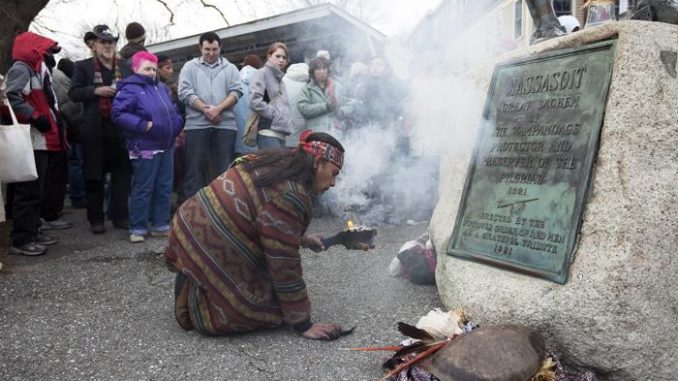
While families all across the US will be indulging over their Thanskgiving Day feasts, hundreds will gather at Cole’s Hill in Plymouth today to commemorate a different tradition – the National Day of Mourning.
The National Day of Mourning, is now in its 45th year and takes place annually on Thanksgiving day. The event honors the death of Native Americans at the hands of early settlers and colonists while at the same time shining a light on modern issues currently facing Native Americans.

BYPASS THE CENSORS
Sign up to get unfiltered news delivered straight to your inbox.
You can unsubscribe any time. By subscribing you agree to our Terms of Use
Latest Video
The following is from an article By Matt Juul via Boston.com :
Now in its 45th year, the National Day of Mourning’s organizers hope to shine a light on modern issues facing Native Americans today, as well as to bring more awareness to the real, horrific story behind Thanksgiving.
“I think there seems to be this myth in this country propagated about Thanksgiving that, ‘Oh, you know, the Pilgrims and the Indians all sat down to have a meal together and they were good friends and everybody lived happily ever after,” says Mahtowin Munro, co-leader of the United American Indians of New England, which organizes the annual event. “It’s really important for us to stand up and talk about what the reality was and to teach others about that reality.”
Many Americans are familiar with the traditional story of Thanksgiving where, in 1621, the Pilgrims and Wampanoag people came together to give thanks and share a meal. However, not many are aware of the events that led to the first official “Day of Thanksgiving.”
As a holiday, Thanksgiving began in 1637 when it was proclaimed by governor John Winthrop of the Massachusetts Bay Colony to celebrate the safe return of the men who had gone to fight against the Pequot in Mystic, Conn. The fighting led to the enslavement and massacre of over 700 men, women, and children from the New England-based tribe, a bloody precursor to what would be centuries of strife for native peoples in the U.S.
In 1970, Wampanoag leader Wamsutta Frank James hoped to speak about this overlooked aspect of history when he was invited to give a speech at a banquet celebrating the 350th anniversary of the landing of the Pilgrims. After reading a draft of his talking points, the dinner’s organizers decided to cancel Wamsutta’s appearance, which prompted him to start the National Day of Mourning.
“We call it a National Day of Mourning because when the Pilgrims and Columbus all landed over here, that was the end of our lives as we knew them – our land had been stolen,” says Moonanum James, son of Wamsutta. “It was like my father’s speech stated: They opened our graves and they grabbed as much as they could take back.”
Rather than dwell on the sins of the past, the UAINE hopes the National Day of Mourning brings more awarness to the problems facing Native Americans today.
For instance, 28 percent of American Indians and Alaska Natives live in poverty, according to the U.S. Department of Health and Human Services’s Office of Minority Health. The National Congress of American Indians Policy Research found that 32.4 percent of the Native American population under the age of 18 also lives in poverty.
According to the the National Court Appointed Special Advocate Association, the mortality rate for American Indian children between the ages of 1 and 14 has increased by 15 percent since 2000, despite the average rate in the U.S. having dropped by 9 percent during the same time period.
The Substance Abuse and Mental Health Services Administration reports that the suicide rate among native youth ages 15 to 24 is 2.5 times higher than the overall national rate.
“Many native people lack access to decent health care,” Munro says. “We have higher rates of diabetes than anybody else in the country. We have higher rates of illness on some reservations.”
Of course, there’s also the inherent racism that still plagues American Indians.
While they aren’t playing on Thanksgiving, the Washington football team with its deplorable logo still refuses to change its name, to the chagrin of many native peoples, including Moonanum.
“It’s no different than [what happened to] the Jews in Nazi Germany with the big nose and all this,” Moonanum says. “How would you like it if I was to go and say, ‘Oh, I’m going to back a team called the Jersey Jews.’ Or if I was going to sit there and say, ‘I’m going up to see the California Catholics,’ and have somebody come out and dress like the Pope and make a mockery out of the Catholic ceremony, the Jewish ceremony. How would you like it?”
Despite the serious issues at hand, the National Day of Mourning does seem to speak to what Thanksgiving should be about, which is bringing people of different faiths and backgrounds together.
The event includes activities such as traditional dances as well as a pot-luck dinner, all of which is organized by volunteers.
“It’s not anti-Thanksgiving,” Moonanum says. “We feed 300-400 people, even up to 500 people on the National Day of Mourning.”
Munro says that the event brings in people from the “four directions,” including native and indigenous peoples from across the country and the world, as well as non-native allies.
“What it speaks to is people joining together for truth and for reality and to speak truth to power,” Munro says. “I think that’s a lot more meaningful than having poor school children dress up as Pilgrims and Indians and do these little, fake pageants.”


